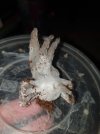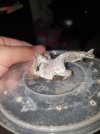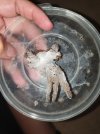- Messages
- 40
- Location
- Hilton derby
I was given a hat hati a couple of weeks ago. It was eating fine a few days ago but when I came to rehouse it today I found it dead. But not in the usual way. It has completely wrapped itself in it's own webbing. Its four hind legs curled under in a death curl and its front four in an attack stance. It's not the moult. I'm not a newbie. I'm at a loss as to why and how it managed to do this...


